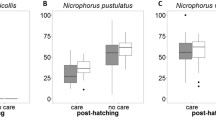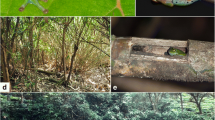Summary
Harsh physico-chemical conditions during early development may select for parental care. However, no study on the evolution of parental care has focused on the physico-chemical conditions in the environment, the physiological needs of early life stages and the significance of parental care. Early development of the bromeliad crab is completed in small rainwater reservoirs in bromeliad leaf axils. Axils not cared for by mother crabs are acidic, hypoxic and contain very little Ca2+. Maternal care buffers axil water and increases oxygen and Ca2+ availability. Our results show that (a) bromeliad crab larvae die at pH levels usually found in unattended axils, but develop successfully into the first crab stage at the pH typical of cared-for axils; (b) oxygen concentration in unattended axils is below the critical concentration for larvae, but is high enough for normal respiration in cared-for axils; (c) the calcium demand of larvae for moulting and development cannot be satisfied in unattended axils, but is met by the higher calcium content of cared-for axils. Therefore, physicochemical conditions in the bromeliad axil habitat exert strong selection for the maintenance of parental care in the bromeliad crab.
Similar content being viewed by others
References
Aldrich JC, Regnault M (1990) Individual variations in the response to hypoxia in Cancer pagurus (L.) measured at the excited rate. Mar Behav Physiol 16:225–235
Bro Larsen E (1952) On subtidal beetles from the salt-marsh, their care of progeny and adaptation to salt and tide. Transactions of the Ninth International Congress of Entomology, Amsterdam 1951 1:502–506
Clutton-Brock TH (1991) The evolution of parental care. Princeton University Press, Oxford
Diesel R (1989) Parental care in an unusual environment: Metopaulias depressus (Decapoda: Grapsidae), a crab that lives in epiphytic bromeliads. Anim Behav 38:561–575
Diesel R (1992a) Managing the offspring environment: brood care in the bromeliad crab, Metopaulias depressus. Behav Ecol Sociobiol 30:125–134
Diesel R (1992b) Maternal care in the bromeliad crab, Metopaulias depressus (Decapoda: Grapsidae): Protection of young from predation by damselfly nymphs. Anim Behav 43:803–812
Eickwort AC (1981) Presocial insects. In: Hermann HR (ed) Social insects; vol 11. Academic Press, New York, pp 199–280
Hart JCW (1964) A contribution to the limnology of Jamaica and Puerto Rico. Caribb J Sci 4:331–334
Hartnoll RG (1964) The freshwater grapsid crabs of Jamaica. Proc Linn Soc London 175:145–169
Hartnoll RG (1971) Sesarma cookei n. sp., a grapsid crab from Jamaica (Decapoda: Brachyura). Crustaceana 20:257–262
Hartnoll RG (1988) Evolution, systematics, and geographical distribution. In: Burggren WW, McMahon BR (eds) Biology of the land crabs. Cambridge University Press, Cambridge New York, pp 6–54
Hazlett BA (1983) Parental behavior in decapod Crustacca. In: Rebach S, Dunham DW (eds) Studies in adaptation, the behavior of higher crustacea. John Wiley, New York, pp 171–193
Hessen D, Kristiansen G, Lid I (1991) Calcium uptake from food and water in the crayfish Astascus astacus (L., 1758), measured by radioactive 45Ca (Decapoda, Astacidea). Crustaceana 60:76–83
Laessle AM (1961) Micro-limnological study of Jamaican bromeliads. Ecology 42:499–517
Linsenmair KE (1984) Comparative studies on the social behaviour of the desert isopod Hemilepistus reaumuri and of a Porcellia species. Symp Zool Soc London 53:423–453
Linsenmair KE, Linsenmair C (1971) Paarbildung und Paarzusammenhalt bei der monogamen Wustenassel Hemilepistus reamuri (Crustacea, Isopoda, Oniscoidea). Z Tierpsychol 29:134–155
Rabalais NN, Gore RH (1985) Abbreviated development in decapods. In: Wenner AM (ed) Crustacean issues 2. Larval growth. Balkema, Rotterdam, pp 65–126
Tallamy WD, Wood TK (1986) Convergence patterns in subsocial insects. Annu Rev Entomol 31:369–390
Wilson EO (1971) The insect societies. Harvard University Press, Cambridge, Massachusetts
Wilson EO (1975) Sociobiology, the new synthesis. Belknap Press of Harvard University Press, Cambridge, Massachusetts
Wyatt TD (1986) How a subsocial intertidal beetle, Bledius spectabilis prevents flooding and anoxia in its burrow. Behav Ecol Sociobiol 19:323–331
Author information
Authors and Affiliations
Additional information
Correspondence to: R. Diesel
Rights and permissions
About this article
Cite this article
Diesel, R., Schuh, M. Maternal care in the bromeliad crab Metopaulias depressus (Decapoda) : maintaining oxygen, pH and calcium levels optimal for the larvae. Behav Ecol Sociobiol 32, 11–15 (1993). https://doi.org/10.1007/BF00172218
Received:
Accepted:
Issue Date:
DOI: https://doi.org/10.1007/BF00172218




